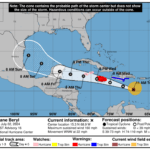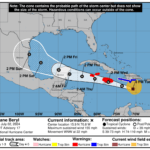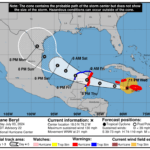
Hurricane Beryl continues to pose a significant threat as a powerful Category 4 storm, maintaining maximum sustained winds of 130 mph. As of 11 PM EDT, the hurricane was located approximately 160 miles southeast of Grand Cayman and 560 miles east-southeast of Tulum, Mexico, moving west-northwest at 21 mph.
The National Hurricane Center has expanded warnings, with key updates including:
- Hurricane Warning now includes Cozumel
- Tropical Storm Warning extended to Campeche on Mexico’s Gulf coast
Areas under hurricane warning:
- Jamaica
- Grand Cayman, Little Cayman, and Cayman Brac
- Yucatan Peninsula from Puerto Costa Maya to Cancun, including Cozumel
Beryl is expected to bring severe conditions, including:
- Destructive winds up to 130 mph, with hurricane-force winds extending 45 miles from the center
- Storm surge of up to 6 to 9 feet in Jamaica, 2 to 4 feet in the Cayman Islands, and 4 to 6 feet along the eastern Yucatan Peninsula
- Heavy rainfall of 4 to 8 inches, with isolated amounts up to 12 inches, risking flash floods and mudslides
- Dangerous surf and rip currents along affected coastlines, expected to spread to the U.S. Gulf Coast by late Friday
The hurricane is forecast to pass near the Cayman Islands overnight before making landfall on the Yucatan Peninsula late Thursday night or Friday morning. While some weakening is expected, Beryl is likely to remain a major hurricane as it passes the Cayman Islands and is predicted to still be at hurricane strength when it reaches the Yucatan.
After crossing the peninsula, Beryl is expected to emerge over the southwestern Gulf of Mexico Friday night, potentially impacting other areas including southern Texas. Residents in all affected areas are urged to complete preparations immediately and follow instructions from local authorities.
Interests in the northwestern Caribbean Sea and the western Gulf of Mexico, including southern Texas, should closely monitor Beryl’s progress.






0 Comments